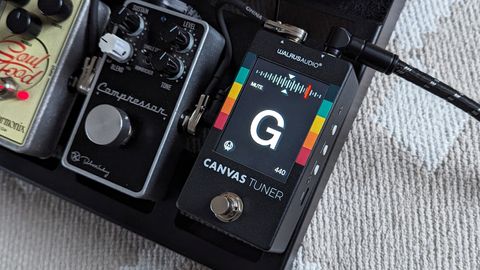Walrus Audio Canvas Tuner: What is it?
Guitar tuners… essential, but exciting? Surely not. They do a vital job but it's up to the other pedals on the 'board to be the fun ones. Walrus Audio disagrees; the tuner pedal can be fun. You can even make it your own.
Part of the US company's growing Canvas range alongside DI and re-amping units, the attractive border colours can only hint and the vibrant screen waiting to be discovered. The dimensions here echo that of the recent Walrus Audio Fundamentals line with top-placed input and outputs and power input on the left.
That leaves the right side for USB input (not just for firmware updates as we'll discover) with Menu select, Up and Down buttons.

The Canvas Tuner has the challenge of entering a market with some very strong established names – including Boss, Peterson, Korg and TC Electronic – so naturally Walrus Audio has sought to bring some USP to the table.
Walrus Audio Canvas Tuner: Performance and verdict
Am I alone in constantly fighting to free up space on my pedalboard? Every millimeter counts in the endless revision of pedals that can be divided into need and want – where four types of reverb pedals fall into the latter category and a tuner is very much in the former camp. A slender tuner pedal is always appreciated then, but has Walrus frustrated things a little here?
Top-mounted jacks are great to see on any pedal but with the power input on the left side, it initially seems to negate the space-saving advantages. On the right it could have at least been on the end of the 'board in many setups (but would mean there's not enough space to access the menu buttons on the other side if placed closely to the next pedal in the chain).
So you can't have the Canvas tuner flush to another pedal but maybe Walrus are ahead of me on this and all is not what it seems. Before I explain that though, the second drawback isn't up for questioning in my mind; some of Walrus's main competition, the Boss TU-3 and standard-sized version of the TC Electronic PolyTune, have power-through to allow daisy-chaining to your other pedals from their output. Certainly not ideal when isolated outputs are always preferred but it can be useful for saving a precious output on your pedal power supply, say for an overdrive pedal. I do this too.
The surprisingly high 300mA power draw here (some modelling amp pedals can be around 400mA for context) also raises an eyebrow and will have to be taken into account when you're considering powering your pedalboard. That's a pretty demanding display.

So the 2.8” TFT LCD display is the main event here, apart from the ±0.1 cent tuning accuracy. And Walrus has a real ace card to play on that front; you can change its orientation up to 270 degrees – which could excuse the power input positioning in some use cases. Why has nobody offered this screen flexibility before?

Whatever the reason, I'm glad to see it. It means a horizontal placement works well for patch cable routing because of the top jack placement too. Would it have worked just as well with the power input at the top? Yes, I think so. But if your 'board needs require this kind of horizontal flexibility, the Canvas could become a prime candidate, especially as it also allows you to upload a photo of your cat to it.
What?

Using the Walrus Audio iO desktop browser app (no installation necessary and a USB-C cable, only registration) you can upload a pic of your liking to the Canvas Tuner to display on its standby screen (only one pic can be stored at any time). So cats, memes or, more usefully perhaps, setlists. Just keep in mind, the more words you have on there on a list of songs, the closer you'll need to be to the screen to read them. Walrus has even included its own old-school-style animated wall bounce screensaver, and eight different colour themes too.
All great, as is the Buffered/True/Monitor/Pass-Thru modes here, but not as important and serious as the actual tuner functions – all easily navigatable with the side menu controls.

Here there are four tuning presets, transpose option for using a capo up to the fifth fret, needle and strobe modes and the useful Tuning Assist mode. This allows for quick remedies on the fly in a live set with the border graphics flashing to let you know you've stayed in tune longer than the 'predetermined threshold'. The referenced pitch is selectable between 390Hz to 490Hz and the flat frequency range of 20Hz to 20KHz means bassists and Nashville tuning fans are equally served well here.
Fast-tracking and accurate; no complaints on the tuning side but for $148.99 I would have liked to see power through included here to provide more of the flexibility players might be used to from other brands. When it demands a 300mA power draw, the Canvas Tuner's sharp, vivid screen isn't a surprise, and it highlights that tuners should always look cool – like any other pedal.
MusicRadar verdict: The vivid display and customised pic options are nice to have, but the screen orientation flexibility will be the most useful feature for some pedalboards. But a high current draw and lack of power output aren't as appealing for the money.
Walris Canvas Tuner: Specifications

- ORIGIN: USA
- TYPE: Tuner pedal
- FEATURES: ±0.1 cent tuning accuracy, Signal to noise ratio: 98dB @ 1kHz, 2.8" TFT LCD display, strobe and needle tuning modes, eight colour schemes, screen saver, custom picture mode, Tune Assist, buffered bypass (input impedance: 1M Ohms and output impedance: 400 Ohms), true bypass option via small signal relay, 390Hz to 490Hz reference pitch
- POWER: 9V DC adaptor (not supplied), 300mA power draw
- CONTACT: Walrus Audio

